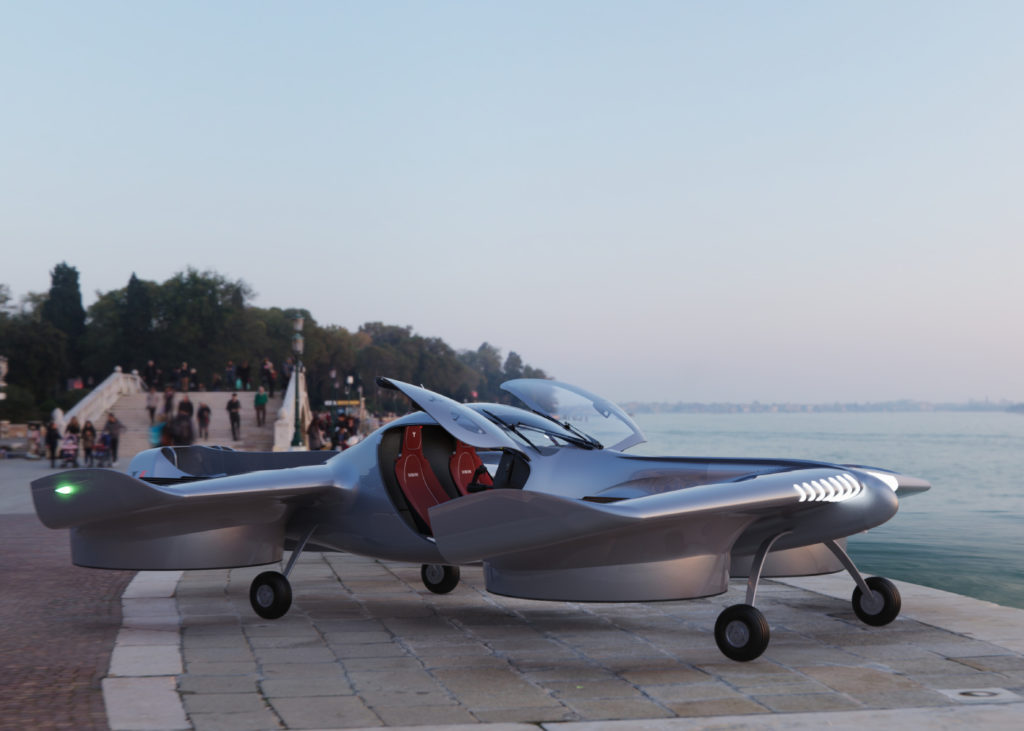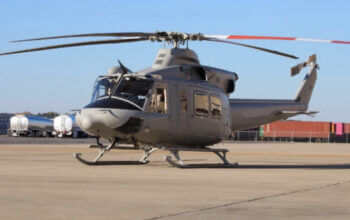Doroni Aerospace recently announced it has been granted a Federal Aviation Administration (FAA) Special Airworthiness Certificate in the experimental category for its eVTOL prototype. The vehicle lies somewhere between a smaller single-seat personal air vehicle (PAV) and a larger aircraft earmarked for air taxi operations.
The company believes it has found the sweet spot in the market for a vehicle with a practical range and payload, yet with a lighter certification burden than for vehicles destined for commercial transport.
I recently visited the company’s facility at Pompano Beach, just north of Miami, Florida, to speak to founder Doron Merdinger on the project’s progress.

This interview has been edited for length and clarity.
Alex Scerri: Doron, can you give us some more details about the Special Airworthiness Certificate and why it is so significant?
Doron Merdinger: It’s important because this vehicle is a new breed of aircraft. A lot of progress was made with the air taxi eVTOLs, but we are targeting a different market, hence a different certification path. It was important for us that the FAA recognized our company and the vehicle. It is a very significant milestone that will let us continue with our development.
Alex Scerri: What are the advantages and limitations of the experimental category type certification?
Doron Merdinger: My philosophy is not to dwell on the disadvantages. It was a huge step in the right direction to see how much the FAA was open to communicating with us, and we see that they are very interested in the product. They are also aware that the rest of the world is progressing rapidly, and we must keep up.
Our end goal is to get the light sport aircraft [LSA] certification. Last July, the FAA published a Notice of Proposed Rulemaking [NPRM] with proposed changes to the airworthiness rules for LSAs. The proposed changes, known as the Modernization of Special Airworthiness Certification [MOSAIC], should significantly expand the definition of LSAs to include aircraft such as our H1. We are, of course, aware of these proposals and have been developing our aircraft to that level.
Alex Scerri: What is your view on pilot certification for these aircraft that will be simpler to operate?
Doron Merdinger: Our philosophy is what we call KISS: keep it smart and simple. We do it in the user interface, reducing points of failure and relying less on pilot inputs. We also look at the interaction between person and machine where, from past data, we can see where mistakes can occur. Everything adds up to increase the safety level and confidence both for the customer and the regulator. It will be a quantum leap compared to the general aviation aircraft out there today because we believe our systems and operational philosophy will prevent a lot of common mistakes.
We will be adding a ballistic parachute, building a crash-resistant structure, and having redundancy from distributed electrical propulsion. Everything we design has safety as a starting point. All the other advantages are already a given. We already know electric motors will be more reliable than internal combustion engines. With fly-by-wire, we can incorporate stability and ease of operation that will not rely only on the pilot’s skill.
Battery cell safety keeps improving because of the experience we are gaining with the massive penetration of ground electric vehicles [EV], and there is a lot of support from the government and community because they understand and want a cleaner ecosystem. From the user experience, we want it to become as natural as jumping in the vehicle and commuting without a lot of overthinking. We will still need pilot training, but we believe it can be much simpler and faster than for legacy aircraft.

Alex Scerri: How is the flight test campaign going?
Doron Merdinger: We have done over 70 flights. This is a full-scale prototype that we are flying untethered indoors. In the last six months, we have been designing the go-to-market product, which is similar to what you saw, but the exterior is different. The basic layout is the same with 10 motors and it is designed to be more energy efficient, stronger, lighter, and easier to mass produce. We are also improving the autopilot and some components.
Alex Scerri: At some point, you will need to do some outside testing. Do you have a plan where that will happen?
Doron Merdinger: We have yet to finalize if we will be using the current prototype for open-air testing or if we will go directly to the next iteration. We have a location here in Florida earmarked for that, and the state is a big supporter of what we are doing. We do get offers from other states and Florida is a bit expensive, but for now, we will be staying here.
Alex Scerri: You mentioned that the external design will change. Will there be any updates on the range and speed specifications?
Doron Merdinger: We still stand by our range targets of over 60 miles [97 kilometers] and a cruise speed of 100 miles per hour [161 kilometers per hour]. If anything, it will become better as the components, especially the batteries, continue to improve. In that sense, time works in our favor.
Alex Scerri: Can you share any details of your suppliers?
Doron Merdinger: I cannot share the suppliers we are using currently. However, we have been in discussions with a few others, including Honeywell. As we understand it, they are putting more focus on air taxi-type vehicles. We know that Garmin is also trying to get into the space, though we are not sure if these big suppliers fully grasp the potential of what we are doing.
I feel comfortable with what we are doing in terms of market strategy and aircraft basics. At the end of the day, this is a new technology that must be validated and tested, and in some ways, our concept has already been validated in many uncrewed aerial vehicles [UAVs] with a similar configuration.
Alex Scerri: Do you think infrastructure will come along to support these PAVs compared to air taxis?
Doron Merdinger: I believe that personal eVTOLs, like Doroni, will not only complement the air taxi market but also create a significant market of its own. By design, our model does not require complex infrastructure. It can be charged at home, at EV charging stations, as well as at vertiports and helipads. Additionally, in the case of being stranded, it can be charged through a standard wall socket using a cable.

Alex Scerri: How do you think local authorities and different jurisdictions will look at these PAVs?
Doron Merdinger: Just in Florida, we have about 70 airpark communities, which are already very welcoming to aviation by default. There are close to 800 of these in the United States, so there is already a substantial market there. If you are the owner of the land or have permission from the owner, you can practically take off and land from any private land.
In terms of flight altitudes, we expect to be only a few hundred feet above the ground, so we are not expecting to fly very high — somewhere between drones and legacy rotorcraft. That should keep us clear of the most controlled airspace also making use of geofencing. There’s a lot of talk in the United States, and specifically here in Florida, about having eVTOL cafés in vibrant cities such as Miami and Orlando. We also had land developers reaching out to us as they wanted to know how to integrate landing facilities in high-rise buildings. Florida is one of the biggest general aviation hubs, and there is a lot of interest and enthusiasm, and the maintenance and handling know-how is already in place. North Carolina, Texas, and Ohio are also aviation-friendly states with large open areas.
Some people ask me if the sky will be overcrowded. It is not going to happen tomorrow, and we are not even able to produce that sort of demand just yet. We have about 400 preorder requests, and it will take time to scale up. Eventually, there may be thousands of these aircraft, but some will be replacing today’s aging general aviation fleet, and they will be quieter with no local emissions, so they definitely have less impact on the environment. It will be an enjoyable experience to view the landscape as you commute or use the vehicle for leisure because you will rarely, if ever, be above the clouds.
Alex Scerri: You recently closed a fundraising round. How did that go?
Doron Merdinger: It went well, but the fundraising effort is continuous until you become cash positive. The goal is to raise US$30 million to finish the full-scale working product that is certified. This is the next phase for us, which will happen in 2024-25 depending on how fast we raise the funds and how our development process fits in with the regulator’s rulemaking efforts. But we are making good progress. There is a lot of support, and we have about 2,400 investors in total.
Alex Scerri: What is the estimated final price for a Doroni H1?
Doron Merdinger: We’re taking a deposit of US$10,000 at this point. The final price is somewhere between US$300,000 and US$375,000. It really depends on the situation in the market. We must see what’s going on with part supplies, which became more expensive during COVID. However, the goal is to make it as affordable as possible. Obviously, we cannot sell large quantities at least in the beginning, so it is a balance between quantity and price.
Alex Scerri: Is there anything you would like to share with the eVTOL community?
Doron Merdinger: As the founder, what excites me most is the flight experience. I believe it will astonish people in a profoundly positive way, akin to the debut of the first TV, fax machine, or iPhone. This will be a completely novel feeling and experience, reshaping how we perceive time and space. Though I’ve already visualized it in my mind, the anticipation of sharing this vision with the rest of the world is overwhelming.









